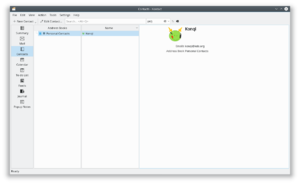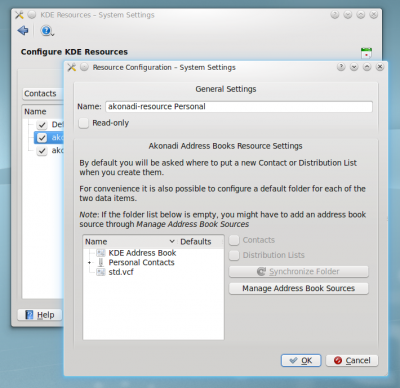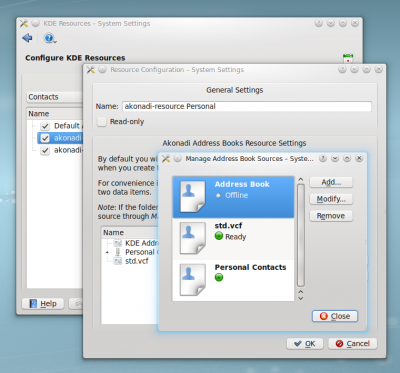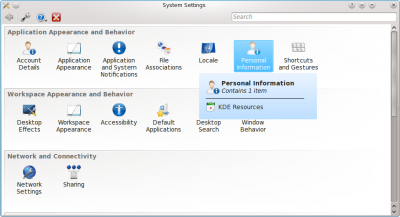KAddressBook
 |
KAddressBook reborn to make your data available to all your applications |
Introdução
O KAddressBook é um trabalho em progresso. Isto não significa que seja instável, mas apenas que não está concluído. O leiaute que você vê nesta versão é muito diferente da versão antiga, e é bem provável que a próxima versão volte a ser diferente, à medida que mais características estejam disponíveis.
Configuração do seu novo livro de endereços
Migração automática
Se você já usou anteriormente o KAddressBook é provável que saiba que era armazenado em ~/.kde/share/apps/kabc/std.vcf. Quando você instala o KDE SC 4.4, a ferramenta de migração automática examinará esse arquivo e irá configurar um recurso do Akonadi utilizando os dados que ele contém. No entanto, é possível que várias outras coisas precisem ser verificadas. Como se trata de uma tecnologia completamente nova, as distribuições podem não ter sido capazes de configurar tudo perfeitamente.
Requisitos iniciais
O Nepomuk precisa estar em execução. Abra as Configurações do Sistema > Avançado > Pesquisa na área de trabalho e habilite o Nepomuk. O Strigi pode ser muito pesado em recursos para o seu hardware, mas a sua ativação é opcional. Desative-o se ele for problemático, mesmo que a falta de indexação necessariamente impactará na medida em que Nepomuk pode trabalhar. O MySQL deve estar funcionando. Isto tem sido problemático em algumas distribuições. Se tiver problemas, provavelmente você será beneficiado pela leitura da página de solução de problemas.
Ativação de recursos
Novamente, a sua distribuição já pode ter feito isto para você, mas verifique em Configurações do Sistema > Avançado > Recursos do KDE. Certifique-se de que os recursos listados estejam habilitados, depois utilize o botão 'Definir como padrão' em 'akonadi-resource Pessoal'. Isto fará com que o livro de endereços dos contatos pessoais esteja disponível para o KMail.

Explore a little further, with the Manage Addressbook Sources button, and you will see that you can examine the settings for your resources:

The resources on your system may not match the list you see in this image - that is of no consequence. Personal Contacts is the one of importance for working with KAddressBook and KMail.
In KDE SC 4.5 the path is slightly different although the process is the same. SystemSettings has been redesigned, so KDE resources is now found under Personal Information.

Estado desta versão
Distribution Lists - the migration tool for your existing distribution lists is not yet released. It is work-in-progress. Where appropriate you can create a new Group - Groups will replace Distribution Lists. Auto completion makes it quite easy to add entries to the group. In KDE SC <= 4.4.2 you can't use the group quite like a distribution list, typing the name and expecting it to be expanded into a list of names. You can, though, copy and paste the list of names from the right-hand panel.
This is not final functionality, but it is a work-around that is possible in some situations. Update - for KDE SC 4.4.3 the alias expansion for Contact Groups from KAddressBook has been backported. Contact Groups still may not be selected in the recipients picker, though.
Invisible fields - some users have been worried because they knew that information was in fields not currently visible. If you check any record in ~/.local/share/contacts/ you will see that the data is not lost. We can expect to see the data becoming visible again in the coming version releases.
Cópia de segurança dos seus dados
The page Akonadi and AddressBook helps you understand the structure of KAddressBook, so that you can be sure that you have backed up all that you need.
Troubleshooting
A number of common 'teething problems' have been reported in versions shipped with KDE SC 4.4. Many of them disappeared with the advent of 4.4.1, but if you still get error messages, Akonadi 4.4 Troubleshooting has solutions to many problems.

